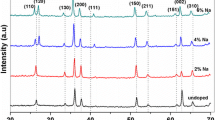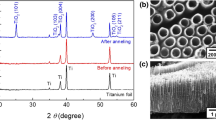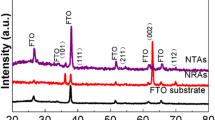Abstract
The synthesis of TiO2 nanorods with anatase structure has been achieved from the necking of truncated nanoparticles by oriented attachment using titanium ethylenediaminetetraacetic acid (EDTA) chelated complex as a molecular precursor. The preparation was carried out under mild conditions using a simple solvothermal process. The influence of EDTA over the growth of nanocrystallites and the various other factors which contribute to the development of 1D TiO2 nanostructure are investigated. At a relatively lower temperature, titania nanopowders are obtained, and the anatase phase crystallization is verified by wide angle X-ray diffraction. The evolution of rod-shaped TiO2 with tapered edges has been confirmed by transmission electron micrographs. The well aligned lattice fringes of TiO2 nanorod towards [001] direction is investigated by HRTEM. The SEM images show the surface configuration of overall aggregates of titania crystallites consisted of primary particles which are densely packed in an orderly texture. The moderate shift in the absorption band towards higher energy region of the absorption spectrum confirms the weak carrier confinement effect in the sample.






Similar content being viewed by others
References
Attar AS, Ghamsari MS, Hajiesmaeilbaigi F, Mirdamadi S (2008) Modifier ligands effects on the synthesized TiO2 nanocrystals. J Mater Sci 43:1723–1729
Baek IC, Vithal M, Chang JA, Yum JH, Nazeeruddin MK, Gratzel M, Chung YC, Seok S (2009) Facile preparation of large aspect ratio ellipsoidal anatase TiO2 nanoparticles and their application to dye-sensitized solar cell. Electrochem Commun 11:909–912
Fujishima A, Honda K (1972) Electrochemical photolysis of water at a semiconductor electrode. Nature 238:37–38
Gopal M, Chan WJM, De Jonghe LC (1997) Room temperature synthesis of crystalline metal oxides. J Mater Sci 32:6001–6008
Hoffmann MR, Martin ST, Choi DW, Bahnemann DW (1995) Environmental applications of semiconductor photocatalysis. Chem Rev 95:69–96
Jun YW, Casula MF, Sim JH, Kim SY, Cheon J, Alivisatos AP (2003) Surfactant-assisted elimination of a high energy facets as a means of controlling the shapes of TiO2 nanocrystals. J Am Chem Soc 125:15981–15985
Kang SH, Choi SH, Kang MS, Kim JY, Kim HS, Hyeon T, Sung YE (2008) Nanorod-based dye-sensitized solar cells with improved charge collection efficiency. Adv. Mater 20:54–58
Kim ID, Rothschild A, Lee BH, Kim DY, Jo SM, Tuller HL (2006) Ultra sensitive chemiresistors based on electrospun TiO2 nanofibers. Nano Lett 6:2009–2013
Li Y, Guo Y, Liu Y (2005) Synthesis of high purity TiO2 nanoparticles from Ti(SO4)2 in presence of EDTA as complexing agent. China Particuol 3:240–242
Li XL, Peng Q, Yi JX, Wang X, Li Y (2006) Near monodisperse TiO2 nanoparticles and nanorods. Chem Eur J 12:2383–2391
Linsebigler AL, Lu GQ, Yates YT (1995) Photocatalysis on TiO2 surfaces: principles, mechanism and selected results. Chem Rev 95:735–758
Liu B, Aydil ES (2009) Growth of oriented single-crystalline rutile TiO2 nanorods on transparent conducting substrates for dye-sensitized solar cells. J Am Chem Soc 131:3985–3990
Malik WU, Tuli GD, Madan RD (2001) Selected topics in inorganic chemistry, 7th edn. S. Chand, New Delhi, pp 332–374
Nian JN, Teng H (2006) Hydrothermal synthesis of single-crystalline TiO2 nanorods with nanotubes as the precursor. J Phys Chem B 110:4193–4198
Park NG, Van de Lagemaat J, Frank AJ (2000) Comparison of dye-sensitized rutile and anatase based TiO2 solar cells. J Phys Chem B 104:8989–8994
Park J, Joo S, Kwon G, Jang Y, Hyeon T (2007) Synthesis of monodisperse spherical nanocrystals. Angew Chem Int Ed 46:4630–4660
Pecsok RL, Maverick EF (1954) A polarographic study of the titanium-ethylenediaminetetraacetate complexes. J Am Chem Soc 76:358–362
Penn RL, Banfield JF (1999) Morphology development and crystal growth in nanocrystalline aggregates under hydrothermal conditions: Insights from titania. Geochim Cosmochim Acta 63:1549–1557
Polleux J, Pinna N, Antonietti M, Niederberger M (2004) Ligand-directed assembly of preformed titania nanocrystals into highly anisotropic nanostructures. Adv Mater 16:436
Polleux J, Pinna N, Antonietti M, Hess C, Wild U, Schögl R, Niederberger M (2005) Ligand functionality as a versatile tool to control the assembly behavior of performed titania nanocrystals. Chem Eur J 11:3541–3551
Sayilkan H, Sener S, Sener E, Arpac E (1999) New metal alkoxide: synthesis and hydrolysis-condensation reactions; some adsorption features of the hydrolysis-condensation products. J Mater Sci 34:5325–5330
Schubert U, Arpac E, Glaubitt W, Helmerich A, Chau C (1992) Primary hydrolysis products of metacrylate modified titanium and zirconium alkoxides. Chem Mater 4:291–295
Wada S, Chikamori H, Noma T, Suzuki T (2000) Synthesis of new titanium chelated complexes stabilized in aqueous solution and their stability on pH and temperature. J Mater Sci Lett 19:1855–1858
Wagemaker M, Krol RVD, Kentgens APM, Well AAV, Mulder FM (2001) Two phase morphology limits lithium diffusion in TiO2 (anatase): A 7Li MAS NMR study. J Am Chem Soc 123:11454–11461
Wang CC, Ying JY (1999) Sol-gel synthesis and hydrothermal processing of anatase and rutile titania nanocrystals. Chem Mater 11:3113–3120
Yang HG, Zeng HC (2004) Lattice strain directed synthesis of anatase TiO2 single crystal microplatelet arrays on r-MoO3 (010) template. J Phys Chem B 108:819–823
Yun HJ, Lee H, Joo JB, Kim W, Yi J (2009) Influence of aspect ratio of TiO2 nanorods on the photocatalytic decomposition of formic acid. J Phys Chem C 113:3050–3055
Yusuke M, Makoto K, Valery P, Shu Y, Tsugio S, Masato K, Koji T (2009) Hydrothermal synthesis of brookite type TiO2 photocatalysts using a water-soluble Ti-complex coordinated by ethylenediaminetertraacetic acid. Nippon seramikkusu kyokai gakujutsu ronbunshi 117:320–325
Acknowledgements
The authors are grateful to Prof. B. Viswanathan, National Center for Catalysis Research, IIT Madras for useful discussion and valuable suggestions. We thank Prof. T. Pradeep, IIT Madras for TEM facility. The authors are grateful to DST-SERC for the instrumentation facility provided at Loyola College through a project (SR/S2/LOP-03/2007).
Author information
Authors and Affiliations
Corresponding author
Rights and permissions
About this article
Cite this article
Christy, P.D., Melikechi, N., Nirmala Jothi, N.S. et al. Synthesis of TiO2 nanorods by oriented attachment using EDTA modifier: a novel approach towards 1D nanostructure development. J Nanopart Res 12, 2875–2882 (2010). https://doi.org/10.1007/s11051-010-9877-6
Received:
Accepted:
Published:
Issue Date:
DOI: https://doi.org/10.1007/s11051-010-9877-6




